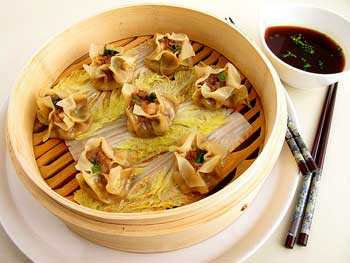 I love the custom of Chinese dim sum because it brings friends and family together at the table. This style of food is enjoyed with small plates, which allows the diner the opportunity to enjoy many different dishes in small quantities. For me it's a way to find a favorite and stick with it. In every Chinatown in the United States you would be hard pressed not to find a restaurant offering dim sum or what I like to call Chinese brunch. I remember my first time at a dim sum place in New York with a group of Asian friends. I was lucky to have help in deciphering the menus and communicating with the waitresses, who brought out the food on trolleys and took orders by stamping slips of paper. It's truly an experience that transports the nonnative eater to China.
I love the custom of Chinese dim sum because it brings friends and family together at the table. This style of food is enjoyed with small plates, which allows the diner the opportunity to enjoy many different dishes in small quantities. For me it's a way to find a favorite and stick with it. In every Chinatown in the United States you would be hard pressed not to find a restaurant offering dim sum or what I like to call Chinese brunch. I remember my first time at a dim sum place in New York with a group of Asian friends. I was lucky to have help in deciphering the menus and communicating with the waitresses, who brought out the food on trolleys and took orders by stamping slips of paper. It's truly an experience that transports the nonnative eater to China.
It's been many years since I've had good traditional dim sum and my longing for dumplings has increasingly grown since. With the arrival of Chinese New Year, there is no better reason to make my dim sum favorite, shu mai, at home. These dumplings are typically made of shrimp and pork, but they can also be made of pork and mushroom, and even mutton, depending on the regional cuisine. No matter the filling, shu mai always retain a characteristic look: they sort of resemble little volcanoes with filling erupting from their tops. They only need limited skill to form the shape and the best shortcut of all is using wonton wrappers instead of making the dough. It takes just minutes to bring together this easy dim sum, which also makes a fun party appetizer.
The key to tender dumplings is a quick steam. I use the traditional method of a bamboo steamer placed in a wok. The basket is lined with cabbage leaves to keep the dumplings from sticking. Then they are steamed in batches so as not to overcrowd. Bamboo steamer baskets make a fun presentation when brought to the table full of dumplings. If you don't have the Chinese set-up, use a shallow pan with a tight-fitting lid. Place a round rack or steamer basket over the water. For lining the steamer, substitute parchment paper for cabbage leaves but make sure to cut a few slashes to make way for the steam to come through. Whichever method is used, you are guaranteed to have steaming hot, flavorful dumplings at the ready to celebrate Chinese New Year if you are Chinese or not.
Pork and Shrimp Dumplings or Shu Mai
5 ounces ground pork
5 ounces shrimp, peeled, deveined, and coarsely chopped
3 scallions, chopped
1 tablespoon grated ginger (about 1/2-inch piece)
1 tablespoon Chinese cooking wine
1 tablespoon soy sauce
1 teaspoon toasted sesame oil
fine sea salt
freshly ground black pepper
20 wonton wrappers
Napa cabbage leaves, for steaming
1 large egg, beaten, for egg wash
for the dipping sauce:
1/4 cup soy sauce
1 tablespoon lime juice (about 1/2 lime)
1 scallion, chopped
Combine the pork, shrimp, scallions, ginger, rice wine, soy sauce, and sesame oil in a bowl. Season with salt and pepper. Stir well to combine.
Bring a wok or shallow pan filled with 1 to 2 inches of water to a simmer over high heat. Line a bamboo steamer basket with 3 to 4 cabbage leaves. Make sure the water level will not touch the rack of the basket.
To form the dumplings, place about 2 teaspoons of filling in each wonton wrapper. Keep the wrappers covered with plastic wrap while working. Using a brush, dab the edges with egg wash. Begin pinching and pleating the edges so that the filling forms a ball inside the wrapper but still peaks out from the top. Place the dumplings on a tray lined with parchment paper and keep covered with plastic wrap until ready to cook.
Arrange half the dumplings in the steamer basket, spacing them a few inches apart. Place over the simmering water, cover, and steam for 6 minutes. Remove to a hot platter. Steam the remaining dumplings.
Meanwhile, make the dipping sauce. Combine soy sauce, lime juice, and scallion in a small bowl. Serve the dipping sauce alongside dumplings.
Yield: about 4 to 6 appetizer servings.
Joseph Erdos is a New York–based writer and editor, butabove all a gastronomer and oenophile. He shares his passion for foodon his blog, Gastronomer's Guide , which features unique recipes and restaurant reviews among many other musings on the all-encompassing topic of food.

